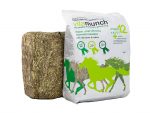1 year product guarantee
Free delivery on most orders over £40
Rated 4.9/5 stars on Feefo

Researched & tested products

Innovating for over 20 years!
Supporting Redwings Horse Sanctuary & Brooke
Feefo Gold Trusted Service Award Winner
Get more time to pay with Klarna
Understanding Equine Digestion
The digestive system of the modern horse
The evolutionary horse was constantly on the move, covering large distances across grassy plains, browsing and foraging as it went. The digestive system of the modern horse is still that which evolved to serve the lifestyle of little-and-often feeding. As such there remains an intrinsic need to eat for the majority of the day in horses today.
The digestive tract is huge and accounts for about 15% of a horse’s total weight when full.
The process of digestion breaks down the feedstuffs a horse eats into various sub-units that can be digested, absorbed and utilised by the individual cells of the body. Principally the horse operates a dual system of digestion – a foregut that digests simple carbohydrate sources, proteins and oils, and a large hindgut for digesting fibre.
The digestive system from start to finish:
- The Mouth
Food is taken into the mouth either by the lips, or, in the case of forage, torn by the incisor teeth. The horse is able to use its lips to deftly select (or otherwise) its preferences – we all know plenty of horses that can pick out the bits they don’t like from their feed.
The dental arcade of the horse consists of sharp biting teeth at the front, the incisors, followed further up the jaw by the chewing and grinding teeth of the premolars and molars. The rhythmical chomping sound that horses make when chewing is one of the signs of a contented horse.
Chewing and grinding break the food down into tiny particles for mixing with saliva. The more chewing, the smaller the particles, and the more mixing with saliva, which then lubricates the bolus of food that passes down to the stomach.
Chewing time is longer for hay than compound feeds – per kilo of hay a horse produces typically 6 litres of saliva, compared to only about 2 litres for the equivalent weight of compound.
- The Stomach
The stomach is small in comparison to the rest of the digestive tract, holding typically 9-15 litres, accounting for about 10% of the digestive capacity, and as it works best when approximately two thirds full, its active capacity is therefore less.
This relatively small size of the stomach reflects the little and often way a horse evolved to receive its food. A large stomach isn’t necessary when food is constant. A quirk of this design however is that the stomach produces acid continuously regardless of whether food is there or not. This is in contrast to the mouth, which only produces saliva when the horse chews. This continual production of gastric acid is thought to lie behind the development of certain stereotypical behaviours and also gastric ulcers in horses that spend periods without access to food, that then produce only limited amounts of any acid-buffering saliva.
- The Small Intestine
Like the stomach, the small intestine is relatively small compared to the total digestive capacity of the horse, again reflecting the little and often, high fibre diet of the horse.
The small intestine is a narrow tube of about 25 metres in length and comprises about 20% of the horses digestive capacity. Starches, sugar, protein and oils are digested here, as are minerals, trace elements and vitamins A, D and E.
Depending on the diet, food particles can pass through the small intestine typically between 45 minutes and two hours. Again its size reflects the evolutionary need -to digest the naturally low or moderate amounts of soluble carbohydrates, protein etc., in a mainly fibrous diet.
- The large Intestine
Animals cannot digest fibre by themselves – they do so in a symbiotic relationship with microbes, whereby fibre is broken down by microbial fermentation. In the horse, this fermentation takes place in the large intestine or hindgut.
This comprises about two-thirds of the whole digestive tract, and can hold about 30 gallons (about 100 litres) of water and food. Here the microbes ferment fibre, together with any starches, sugars, oils and proteins that have by-passed the small intestine. In horses on a principally forage diet, feedstuffs can stay in the hindgut for as long as 48 hours.
Absorbed from the hindgut are the volatile fatty acids and B vitamins generated by the microbial fermentation of fibre, plus water and some minerals, notably phosphorous.
The microbial population adapts to match the kind of diet it receives. Any sudden changes to the horse’s overall diet will not give the microbes time to adapt and can cause digestive upset. Such changes are usually the result of sudden drops in fibre or forage intake, or from large excesses of starch and sugar arriving from the small intestine, for instance if hard feed intake is increased suddenly.
Category
Feeding and Nutrition, Nutrition, WellbeingRelated Products
View all products-
 Munch Net£4.50 View product
Munch Net£4.50 View productMunch Net
Extend eating times and help prevent boredom with this small-holed…
-
 Vitamunch Marvellous Meadow£4.50 – £22.50 View product
Vitamunch Marvellous Meadow£4.50 – £22.50 View productVitamunch Marvellous Meadow
Keep your horse occupied for longer with this high fibre,…
